Optimizing the Ecological Network to Construct an Ecological Security Pattern in a Metropolitan Area: A Case Study of the Jinan Metropolitan Area, China
Abstract
1. Introduction
2. Materials and Methods
2.1. Study Area
2.2. Data Sources
2.3. Methods
2.3.1. ES Identification
- (1)
- Landscape Element Identification
- (2)
- HQ Assessment
- (3)
- ES Extraction
2.3.2. Comprehensive Resistance Surface Construction
2.3.3. EC Extraction
2.3.4. EN Optimization and Evaluation
- (1)
- Identification of priority protection areas
- (2)
- Determination of Priority Recovery Areas
- (3)
- EN Optimization
- (4)
- EN Robustness Evaluation
3. Results
3.1. ES Extraction
3.1.1. MSPA Data Analysis
3.1.2. HQ Analysis
3.1.3. ES Analysis
3.2. EC Identification
3.2.1. Comprehensive Resistance Surface
3.2.2. EC Extraction
3.3. EN Optimization and Optimization Effect
3.3.1. Priority Protection Areas
3.3.2. Priority Recovery Areas
3.3.3. EN Optimization
3.3.4. Evaluation of the Optimization Effect of EN
4. Discussion
4.1. Advantages of Optimization Methods
4.2. ESP and Recommendations
- (1)
- One Belt. The “One Belt” refers to the Dongping Lake-Taiyi Mountain ecological conservation belt, which encompasses the region where the ESs of the Jinan metropolitan area are predominantly concentrated. Dongping Lake is the largest lake within the Jinan metropolitan area and exhibits high HQ. Dongping Lake also serves as a critical area for flood storage. However, the development of safety infrastructure in the region has been relatively slow, which poses a potential threat to ecological development and construction. As a national ecological wetland park, it is essential to enhance ecological infrastructure and proactively prevent ecological degradation. The Taiyi Mountain Range, characterized by its complex topography and relatively low level of development, maintains high ecological quality and dense vegetation coverage, making it ecologically significant for species migration and habitat activities. Nevertheless, the presence of numerous historical open-pit mines and steep terrain in the central and southern parts of Shandong Province have led to significant challenges related to soil erosion, particularly in the southern mountainous areas, such as Jinan [63]. Currently, the Taiyi Mountain Ecological Protection and Restoration Project has been incorporated into the Shandong Province Land Use Plan. Therefore, while safeguarding existing high-quality habitats, ecological restoration efforts should prioritize reducing bare land development. Reforestation initiatives should be implemented on farmland located on steep slopes, and management practices concerning bare land and mountain ecological restoration should be strengthened.
- (2)
- Two Axes. The “Two Axes” are the ecological core axis and the ecological river axis. The ecological core axis refers to the spatial linkage formed by Dongping Lake, Mount Tai, Heban Mountain, and the Seashell Island coastal wetland area. This ecological core axis exerts a significant controlling and radiating influence on the ecological structure of the study area. However, the spatial distance between the Seashell Island coastal wetland area and Heban Mountain is relatively large, which may hinder the functional continuity of the axis. By prioritizing ecological development at the intersection of the ecological core axis and the Yellow River, a new ecological core zone can be established, thereby improving the overall coherence and effectiveness of the ecological core axis. The ecological river axis follows the course of the Yellow River, traversing the Jinan metropolitan area and functioning as a crucial EC within the study region. Jinan represents a key node along this ecological river axis. Despite its status as the central city of the metropolitan area, Jinan faces the challenge of being a “weak provincial capital.” Therefore, it will be prioritized in future development plans. Notably, the Yellow River flows as a suspended river through Jinan, presenting potential flood risks to the urban area. During urban development and construction, flood control projects should be carried out simultaneously. Furthermore, strict regulations should be established to safeguard the ecological integrity of the Yellow River and its surrounding environment. Both the ecological core axis and the ecological river axis provide essential support for the ecological environment and socio-economic development of the urban agglomeration due to their extensive spatial influence. Therefore, it is imperative to enhance the connectivity and implement coordinated protection measures for both the ecological core axis and the Yellow River ecological axis.
- (3)
- Two Zones. The “Two Zones” refers to the Liaocheng ecological supplement zone and Dezhou-Jinan-Binzhou ecological supplement zone located in the northwestern part of Shandong Province. The terrain of this area is mainly plain, and the main land use types are farmland and construction land. There is a notable risk of soil desertification in the area. The northwestern part of Shandong Province constitutes a key area within the province’s “three zones and nine fields” agricultural spatial framework, where farmland protection represents a critical objective. The frequent agricultural activities and development and construction have led to a relatively low HQ and a lack of ESs in this area. Therefore, integrating farmland protection with ecological function enhancement through measures such as the establishment of farmland protection forests can facilitate the coordinated development of agricultural sustainability and ecological conservation. In addition, this study mitigated the issue of uneven distribution of ESs to some extent through the application of EPRL; however, the overall number of ESs within the region remains relatively limited. In the future, the establishment of buffer zones could facilitate the development of smaller areas with favorable ecological conditions into ESs, thereby further addressing ecological gaps.
- (4)
- Five Cores. The ecological core area includes the Dongping Lake region, the Taishan region, the Culai Mountain region, the Heban Mountain region, and the Seashell Island coastal wetland area. These regions exhibit high levels of HQ and constitute key components of the EPRL. Among them, Dongping Lake, Mount Tai, and Culai Mountain form the ecological framework of Tai’an’s ESP, creating a spatial configuration known as “two mountains and one lake”. Due to the “mountain–urban integration” development model adopted in Tai’an, the southern region of Mount Tai has relatively high ecological resistance values and is under significant pressure from anthropogenic activities. Therefore, stringent ecological protection measures should be implemented to prevent uncontrolled development activities from encroaching upon the northern part of Mount Tai. Culai Mountain is primarily covered by forest and saves as an important ES and ecological security barrier. Therefore, the primary emphasis should be placed on ecological conservation. Heban Mountain is located at the confluence of the regions of Jinan, Binzhou, and Zibo, which is a crucial node for ecological connectivity among the three surrounding cities. However, it is surrounded by areas such as Zouping City, Zhoucun District, and Zhangqiu District, which exhibit high resistance values. This has led to a large number of ecological breakpoints and ecological obstacle points around Heban Mountain, impeding its connectivity with other ESs. Therefore, maintaining the ECs surrounding Heban Mountain is essential to prevent its isolation from the broader EN [64]. The Seashell Island coastal wetland area is a national natural reserve that serves as a critical stopover site for migratory birds, providing essential habitats for their overwintering, feeding, and breeding. As an important ES, it plays an important role in maintaining ecological health and stability of the coastline. Furthermore, being the estuary of both the Majia River and the Tuhai River, it significantly influences the ecological development and sustainability of these river systems. Therefore, enhancing the conservation and restoration of coastal wetlands is crucial to achieving the sustainable development of wetland ecosystems. Currently, the Seashell Island coastal wetland area has been incorporated into the Bohai Sea Yellow River Delta Nature Reserve Restoration and Upgrading Project.
4.3. Limitations
5. Conclusions
- (1)
- The initial EN of the study area comprises 40 ESs and 84 ECs. Four types of priority areas were identified, including 75 ecological pinch points, 11 ecological footstones, 39 ecological obstacle points, and 109 ecological breakpoints. There is a noticeable imbalance in the spatial distribution of ESs and ECs across the Jinan metropolitan area. The central-eastern part of the study area benefits from the presence of the Taiyi Mountain Range and the Yellow River, resulting in a more favorable ecological environment. This region is characterized by a high concentration of ESs and a denser EC network. In contrast, the northwestern plains are primarily dominated by cropland, which leads to relatively fewer and lower-quality ESs and ECs.
- (2)
- From the perspective of enhancing EN connectivity, this study employed priority areas to optimize the EN. The initially optimized EN comprised 50 ESs and 102 ECs. Considering the spatial distribution pattern of ESs, this study further optimized the EN by incorporating the EPRL into the analysis. Consequently, seven additional ESs and 22 additional ECs were identified. The newly added ESs and ECs were mainly located in the southeast region, as well as in the Liaocheng and Dezhou region in the northwestern part of the study area, alleviating the problem of uneven ES distribution. Ultimately, the final optimized EN comprises 57 ESs and 124 ECs.
- (3)
- The robustness of optimization of the EN has more obvious improvement. Under random and deliberate attacks, the average robustness values of the optimized EN increased from 0.435 to 0.459 and from 0.093 to 0.128, respectively. This indicates an improvement in the stability of the optimized EN. Finally, this study established an ESP of “One Belt, Two Axes, Two Zones, and Five Cores” for the Jinan metropolitan area and proposed corresponding recommendations.
Author Contributions
Funding
Institutional Review Board Statement
Informed Consent Statement
Data Availability Statement
Conflicts of Interest
References
- Zhao, Y.; Zhang, P.; Xu, H.; Liu, W. Assessment and Optimization of Ecological Networks in Trans-Provincial Metropolitan Areas—A Case Study of the Xuzhou Metropolitan Area. Land 2025, 14, 45. [Google Scholar] [CrossRef]
- Wang, Y.; Bin Mohamed Afla, M.R. Evaluation of Urban Ecological Benefits Utilizing Vegetated Areas Metrics in Nanjing, China. Geocarto Int. 2024, 39, 2395321. [Google Scholar] [CrossRef]
- Fletcher, R.J.; Didham, R.K.; Banks-Leite, C.; Barlow, J.; Ewers, R.M.; Rosindell, J.; Holt, R.D.; Gonzalez, A.; Pardini, R.; Damschen, E.I.; et al. Is Habitat Fragmentation Good for Biodiversity? Biol. Conserv. 2018, 226, 9–15. [Google Scholar] [CrossRef]
- Chase, J.M.; Blowes, S.A.; Knight, T.M.; Gerstner, K.; May, F. Ecosystem Decay Exacerbates Biodiversity Loss with Habitat Loss. Nature 2020, 584, 238–243. [Google Scholar] [CrossRef] [PubMed]
- Beita, C.M.; Murillo, L.F.S.; Alvarado, L.D.A. Ecological Corridors in Costa Rica: An Evaluation Applying Landscape Structure, Fragmentation-Connectivity Process, and Climate Adaptation. Conserv. Sci. Pract. 2021, 3, e475. [Google Scholar] [CrossRef]
- Shuai, N.; Hu, Y.; Chen, J.; Liu, X.; Bai, Y. Does Ecological Network Affect the Construction Land Spatial Development Intensity? —An Empirical Study Based on the Main Urban Area of Jinan, China. Ecol. Inform. 2024, 81, 102609. [Google Scholar] [CrossRef]
- Baggio, J.A.; Hillis, V. Managing Ecological Disturbances: Learning and the Structure of Social-Ecological Networks. Environ. Modell. Softw. 2018, 109, 32–40. [Google Scholar] [CrossRef]
- Forman, R.T.T. Some General Principles of Landscape and Regional Ecology. Landsc. Ecol. 1995, 10, 133–142. [Google Scholar] [CrossRef]
- Yu, K. Security Patterns and Surface Model in Landscape Ecological Planning. Landsc. Urban Plan. 1996, 36, 1–17. [Google Scholar] [CrossRef]
- Opdam, P.; Steingröver, E.; van Rooij, S. Ecological Networks: A Spatial Concept for Multi-Actor Planning of Sustainable Landscapes. Landsc. Urban Plan. 2006, 75, 322–332. [Google Scholar] [CrossRef]
- De Montis, A.; Ganciu, A.; Cabras, M.; Bardi, A.; Mulas, M. Comparative Ecological Network Analysis: An Application to Italy. Land Use Policy 2019, 81, 714–724. [Google Scholar] [CrossRef]
- Men, D.; Pan, J. Ecological Network Identification and Connectivity Robustness Evaluation in the Yellow River Basin under a Multi-Scenario Simulation. Ecol. Modell. 2023, 482, 110384. [Google Scholar] [CrossRef]
- Dai, L.; Liu, Y.; Luo, X. Integrating the MCR and DOI Models to Construct an Ecological Security Network for the Urban Agglomeration around Poyang Lake, China. Sci. Total Environ. 2021, 754, 141868. [Google Scholar] [CrossRef]
- Huang, Q.; Ma, Y. Ecological Network Construction in High-Density Water Network Areas Based on a Three-Dimensional Perspective: The Case of Foshan City. Sustainability 2024, 16, 7636. [Google Scholar] [CrossRef]
- Skokanová, H.; Netopil, P.; Havlíček, M.; Šarapatka, B. The Role of Traditional Agricultural Landscape Structures in Changes to Green Infrastructure Connectivity. Agric. Ecosyst. Environ. 2020, 302, 107071. [Google Scholar] [CrossRef]
- Zeng, W.; He, Z.; Bai, W.; He, L.; Chen, X.; Chen, J. Identification of Ecological Security Patterns of Alpine Wetland Grasslands Based on Landscape Ecological Risks: A Study in Zoigê County. Sci. Total Environ. 2024, 928, 172302. [Google Scholar] [CrossRef]
- Ma, J.; Yu, Q.; Wang, H.; Yang, L.; Wang, R.; Fang, M. Construction and Optimization of Wetland Landscape Ecological Network in Dongying City, China. Land 2022, 11, 1226. [Google Scholar] [CrossRef]
- Li, Y.; Wei, M.; Zhou, R.; Jin, H.; Chen, Y.; Hong, C.; Duan, W.; Li, Q. Identifying Priority Restoration Areas Based on Ecological Security Pattern: Implications for Ecological Restoration Planning. Ecol. Indic. 2025, 174, 113486. [Google Scholar] [CrossRef]
- Newton, A.C.; Hodder, K.H.; Cantarello, E.; Perrella, L.; Birch, J.C.; Robins, J.; Douglas, S.; Moody, C.; Cordingley, J.E. Cost–Benefit Analysis of Ecological Networks Assessed through Spatial Analysis of Ecosystem Services. J. Appl. Ecol. 2012, 49, 571–580. [Google Scholar] [CrossRef]
- Sun, W.; Yu, Q.; Xu, C.; Zhao, J.; Wang, Y.; Miao, Y. Construction and Optimization of Ecological Spatial Network in Typical Mining Cities of the Yellow River Basin: The Case Study of Shenmu City, Shaanxi. Ecol. Process 2024, 13, 60. [Google Scholar] [CrossRef]
- Adriaensen, F.; Chardon, J.P.; De Blust, G.; Swinnen, E.; Villalba, S.; Gulinck, H.; Matthysen, E. The Application of ‘Least-Cost’ Modelling as a Functional Landscape Model. Landsc. Urban Plan. 2003, 64, 233–247. [Google Scholar] [CrossRef]
- Peng, J.; Yang, Y.; Liu, Y.; Hu, Y.; Du, Y.; Meersmans, J.; Qiu, S. Linking Ecosystem Services and Circuit Theory to Identify Ecological Security Patterns. Sci. Total Environ. 2018, 644, 781–790. [Google Scholar] [CrossRef]
- McRae, B.H.; Dickson, B.G.; Keitt, T.H.; Shah, V.B. Using Circuit Theory to Model Connectivity in Ecology, Evolution, and Conservation. Ecology 2008, 89, 2712–2724. [Google Scholar] [CrossRef]
- Zhuge, M.; Hu, Y. Construction and Optimization of Ecological Network in Guanzhong Region of Shaanxi Province Based on PLUS-InVEST-Linkage Mapper. Land 2024, 13, 2037. [Google Scholar] [CrossRef]
- Chen, X.; Kang, B.; Li, M.; Du, Z.; Zhang, L.; Li, H. Identification of Priority Areas for Territorial Ecological Conservation and Restoration Based on Ecological Networks: A Case Study of Tianjin City, China. Ecol. Indic. 2023, 146, 109809. [Google Scholar] [CrossRef]
- Bombrun, M.; Dash, J.P.; Pont, D.; Watt, M.S.; Pearse, G.D.; Dungey, H.S. Forest-Scale Phenotyping: Productivity Characterisation Through Machine Learning. Front. Plant Sci. 2020, 11, 99. [Google Scholar] [CrossRef] [PubMed]
- Li, C.; Su, K.; Liang, X.; Jiang, X.; Wang, J.; You, Y.; Wang, L.; Chang, S.; Wei, C.; Zhang, Y.; et al. Identification of Priority Areas to Provide Insights for Ecological Protection Planning: A Case Study in Hechi, China. Ecol. Indic. 2023, 154, 110738. [Google Scholar] [CrossRef]
- Song, S.; Gong, Y.; Yu, Y. Integrating Pattern, Process, and Function in Urban Landscape Ecological Network Planning: A Case Study of Harbin Central City. Ecol. Indic. 2024, 159, 111671. [Google Scholar] [CrossRef]
- Wang, Z.; Zhao, X.; Cui, L.; Lei, Y.; Guo, Z.; Wang, J.; Li, J.; Zhai, X.; Rumiao, W.; Wei, L. Identification and Optimization of Urban Wetland Ecological Networks in Highly Urbanized Areas: A Case Study of Haidian District, Beijing. Ecol. Indic. 2025, 170, 113028. [Google Scholar] [CrossRef]
- Heintzman, L.J.; McIntyre, N.E. Assessment of Playa Wetland Network Connectivity for Amphibians of the South-Central Great Plains (USA) Using Graph-Theoretical, Least-Cost Path, and Landscape Resistance Modelling. Landsc. Ecol. 2021, 36, 1117–1135. [Google Scholar] [CrossRef]
- Kharrazi, A.; Akiyama, T.; Yu, Y.; Li, J. Evaluating the Evolution of the Heihe River Basin Using the Ecological Network Analysis: Efficiency, Resilience, and Implications for Water Resource Management Policy. Sci. Total Environ. 2016, 572, 688–696. [Google Scholar] [CrossRef]
- Men, D.; Pan, J. Incorporating Network Topology and Ecosystem Services into the Optimization of Ecological Network: A Case Study of the Yellow River Basin. Sci. Total Environ. 2024, 912, 169004. [Google Scholar] [CrossRef]
- Rosales, F.O.; Fath, B.; Llerena, G. Quantifying a Virtual Water Metabolic Network of the Metropolitan District of Quito, Ecuador Using Ecological Network Methods. J. Ind. Ecol. 2023, 27, 1304–1318. [Google Scholar] [CrossRef]
- Fan, J.; Wang, Q.; Ji, M.; Sun, Y.; Feng, Y.; Yang, F.; Zhang, Z. Ecological Network Construction and Gradient Zoning Optimization Strategy in Urban-Rural Fringe: A Case Study of Licheng District, Jinan City, China. Ecol. Indic. 2023, 150, 110251. [Google Scholar] [CrossRef]
- Liu, W.; Xu, H.; Zhang, X.; Jiang, W. Green Infrastructure Network Identification at a Regional Scale: The Case of Nanjing Metropolitan Area, China. Forests 2022, 13, 735. [Google Scholar] [CrossRef]
- Xu, L.; Zhang, Z.; Tan, G.; Zhou, J.; Wang, Y. Analysis on the Evolution and Resilience of Ecological Network Structure in Wuhan Metropolitan Area. Sustainability 2022, 14, 8580. [Google Scholar] [CrossRef]
- Huo, J.; Shi, Z.; Zhu, W.; Li, T.; Xue, H.; Chen, X.; Yan, Y.; Ma, R. Construction and Optimization of an Ecological Network in Zhengzhou Metropolitan Area, China. Int. J. Environ. Res. Public Health 2022, 19, 8066. [Google Scholar] [CrossRef]
- Zhao, Y.; Xia, J.; Xu, Z.; Zou, L.; Qiao, Y.; Li, P. Impact of Urban Expansion on Rain Island Effect in Jinan City, North China. Remote Sens. 2021, 13, 2989. [Google Scholar] [CrossRef]
- Meng, X.; Meng, F.; Zhao, Z.; Yin, C. Prediction of Urban Heat Island Effect over Jinan City Using the Markov-Cellular Au-tomata Model Combined with Urban Biophysical Descriptors. J. Indian. Soc. Remote Sens. 2021, 49, 997–1009. [Google Scholar] [CrossRef]
- Kong, F.; Yin, H.; Nakagoshi, N.; Zong, Y. Urban Green Space Network Development for Biodiversity Conservation: Identification Based on Graph Theory and Gravity Modeling. Landsc. Urban Plan. 2010, 95, 16–27. [Google Scholar] [CrossRef]
- Wang, C.; Wang, Q.; Liu, N.; Sun, Y.; Guo, H.; Song, X. The Impact of LUCC on the Spatial Pattern of Ecological Network during Urbanization: A Case Study of Jinan City. Ecol. Indic. 2023, 155, 111004. [Google Scholar] [CrossRef]
- Ostapowicz, K.; Vogt, P.; Riitters, K.H.; Kozak, J.; Estreguil, C. Impact of Scale on Morphological Spatial Pattern of Forest. Landsc. Ecol. 2008, 23, 1107–1117. [Google Scholar] [CrossRef]
- Kang, J.; Li, C.; Li, M.; Zhang, T.; Zhang, B. Identifying Priority Areas for Conservation in the Lower Yellow River Basin from an Ecological Network Perspective. Ecosyst. Health Sustain. 2022, 8, 2105751. [Google Scholar] [CrossRef]
- Shuai, N.; Hu, Y.; Gao, M.; Guo, Z.; Bai, Y. Construction and Optimization of Ecological Networks in Karst Regions Based on Multi-Scale Nesting: A Case Study in Guangxi Hechi, China. Ecol. Inform. 2023, 74, 101963. [Google Scholar] [CrossRef]
- Gao, J.; Jiang, Y.; Wang, H.; Zuo, L. Identification of Dominant Factors Affecting Soil Erosion and Water Yield within Ecological Red Line Areas. Remote Sens. 2020, 12, 399. [Google Scholar] [CrossRef]
- Ye, Y.; Chen, C.; Yu, C.; Sun, C.; Geng, S. Identifying Stepping-Stones within Small Wetlands in Highly Urbanized Areas and under Network Construction: A Case Study of the Guangdong–Hong Kong–Macao Greater Bay Area, China. Ecol. Indic. 2025, 176, 113622. [Google Scholar] [CrossRef]
- Modica, G.; Praticò, S.; Laudari, L.; Ledda, A.; Di Fazio, S.; De Montis, A. Implementation of Multispecies Ecological Networks at the Regional Scale: Analysis and Multi-Temporal Assessment. J. Environ. Manag. 2021, 289, 112494. [Google Scholar] [CrossRef] [PubMed]
- Vlková, K.; Zýka, V.; Papp, C.-R.; Romportl, D. An Ecological Network for Large Carnivores as a Key Tool for Protecting Landscape Connectivity in the Carpathians. J. Maps 2023, 20, 2290858. [Google Scholar] [CrossRef]
- Richard, T.T. Forman; Michel Godron Landscape Ecology. Environ. Conserv. 1989, 16, 90. [Google Scholar] [CrossRef]
- McRae, B.H. Isolation by Resistance. Evolution 2006, 60, 1551–1561. [Google Scholar] [CrossRef]
- Wang, F.; Gao, H.; Liu, J.; Fu, T.; Qi, F.; Gao, Y.; Zhao, L. Study on the Characteristics of Ecological Network and Critical Areas of Ecological Restoration in Hebei-Tianjin Coastal Wetlands. Wetlands 2024, 44, 24. [Google Scholar] [CrossRef]
- Zhang, F.; Jia, Y.; Liu, X.; Li, T.; Gao, Q. Application of MSPA-MCR Models to Construct Ecological Security Pattern in the Basin: A Case Study of Dawen River Basin. Ecol. Indic. 2024, 160, 111887. [Google Scholar] [CrossRef]
- Li, J.; Nie, W.; Zhang, M.; Wang, L.; Dong, H.; Xu, B. Assessment and Optimization of Urban Ecological Network Resilience Based on Disturbance Scenario Simulations: A Case Study of Nanjing City. J. Clean. Prod. 2024, 438, 140812. [Google Scholar] [CrossRef]
- Jiang, H.; Peng, J.; Liu, M.; Dong, J.; Ma, C. Integrating Patch Stability and Network Connectivity to Optimize Ecological Security Pattern. Landsc. Ecol. 2024, 39, 54. [Google Scholar] [CrossRef]
- Luo, J.; Fu, H. Constructing an Urban Cooling Network Based on PLUS Model: Implications for Future Urban Planning. Ecol. Indic. 2023, 154, 110887. [Google Scholar] [CrossRef]
- Bhatt, T.R.; Castley, J.G.; Sims-Castley, R.; Baral, H.S.; Chauvenet, A.L.M. Connecting Tiger (Panthera Tigris) Populations in Nepal: Identification of Corridors among Tiger-Bearing Protected Areas. Ecol. Evol. 2023, 13, e10140. [Google Scholar] [CrossRef]
- Fan, F.; Wen, X.; Feng, Z.; Gao, Y.; Li, W. Optimizing Urban Ecological Space Based on the Scenario of Ecological Security Patterns: The Case of Central Wuhan, China. Appl. Geogr. 2022, 138, 102619. [Google Scholar] [CrossRef]
- Huang, L.; Wang, J.; Fang, Y.; Zhai, T.; Cheng, H. An Integrated Approach towards Spatial Identification of Restored and Conserved Priority Areas of Ecological Network for Implementation Planning in Metropolitan Region. Sustain. Cities Soc. 2021, 69, 102865. [Google Scholar] [CrossRef]
- Ferrari, B.; Quatrini, V.; Barbati, A.; Corona, P.; Masini, E.; Russo, D. Conservation and Enhancement of the Green Infrastructure as a Nature-Based Solution for Rome’s Sustainable Development. Urban Ecosyst. 2019, 22, 865–878. [Google Scholar] [CrossRef]
- Bai, Y.; Jiang, B.; Wang, M.; Li, H.; Alatalo, J.M.; Huang, S. New Ecological Redline Policy (ERP) to Secure Ecosystem Services in China. Land Use Policy 2016, 55, 348–351. [Google Scholar] [CrossRef]
- Pashanejad, E.; Kharrazi, A.; Araujo-Gutierrez, Z.M.F.; Robinson, B.E.; Fath, B.D.; Parrott, L. A Functional Connectivity Approach for Exploring Interactions of Multiple Ecosystem Services in the Context of Agricultural Landscapes in the Canadian Prairies. Ecosyst. Serv. 2024, 68, 101639. [Google Scholar] [CrossRef]
- Wu, Z.; Cheng, S.; Xu, K.; Qian, Y. Ecological Network Resilience Evaluation and Ecological Strategic Space Identification Based on Complex Network Theory: A Case Study of Nanjing City. Ecol. Indic. 2024, 158, 111604. [Google Scholar] [CrossRef]
- Qi, S.-Z.; Zhang, X.-X. Urbanization Induced Environmental Hazards from Breakage Hills in the Karst Geological Region of Jinan City, China. Nat. Hazards 2011, 56, 571–574. [Google Scholar] [CrossRef]
- De León, L.F.; Sharpe, D.M.T.; Gotanda, K.M.; Raeymaekers, J.A.M.; Chaves, J.A.; Hendry, A.P.; Podos, J. Urbanization Erodes Niche Segregation in Darwin’s Finches. Evol. Appl. 2019, 12, 1329–1343. [Google Scholar] [CrossRef]

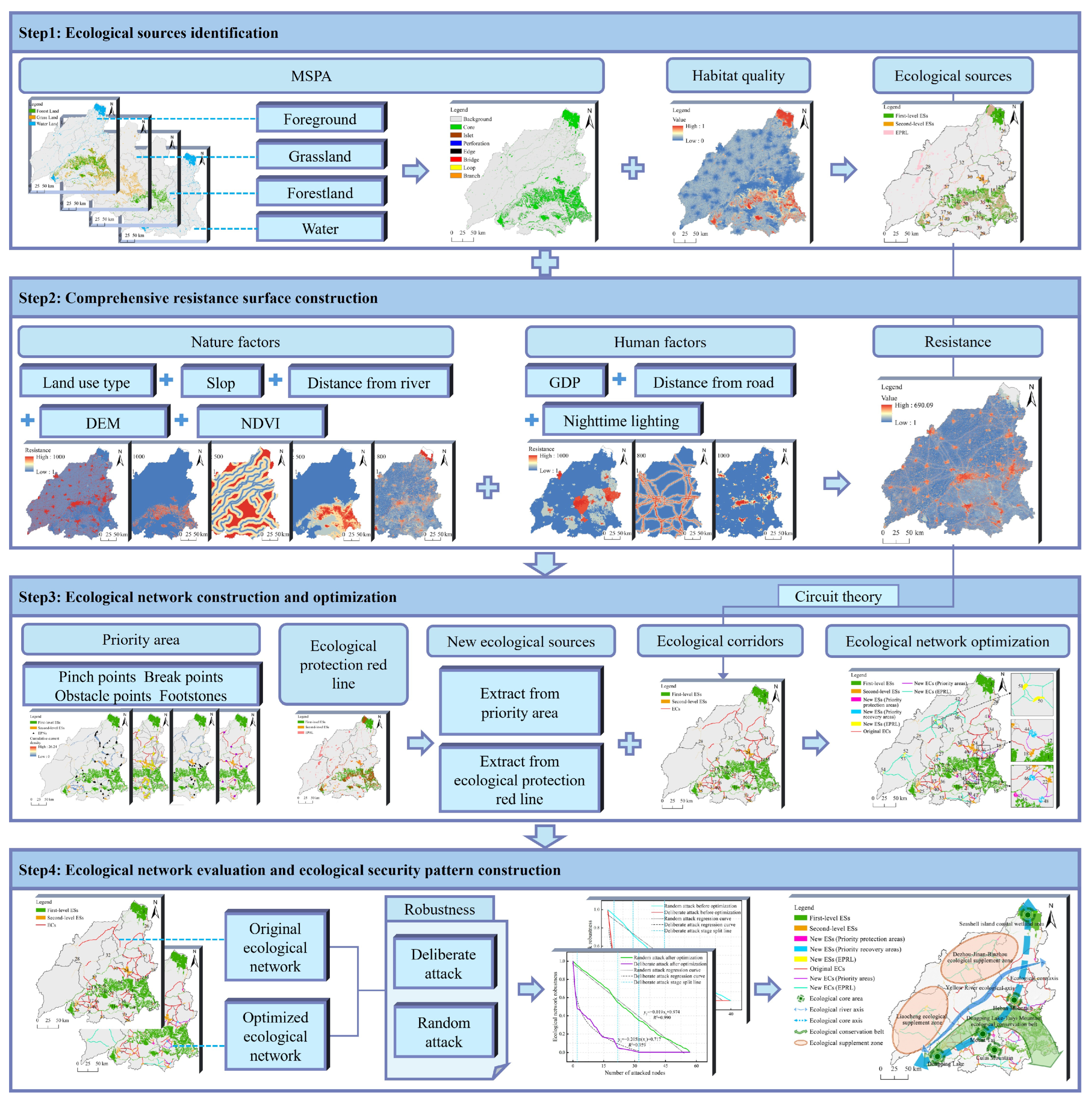
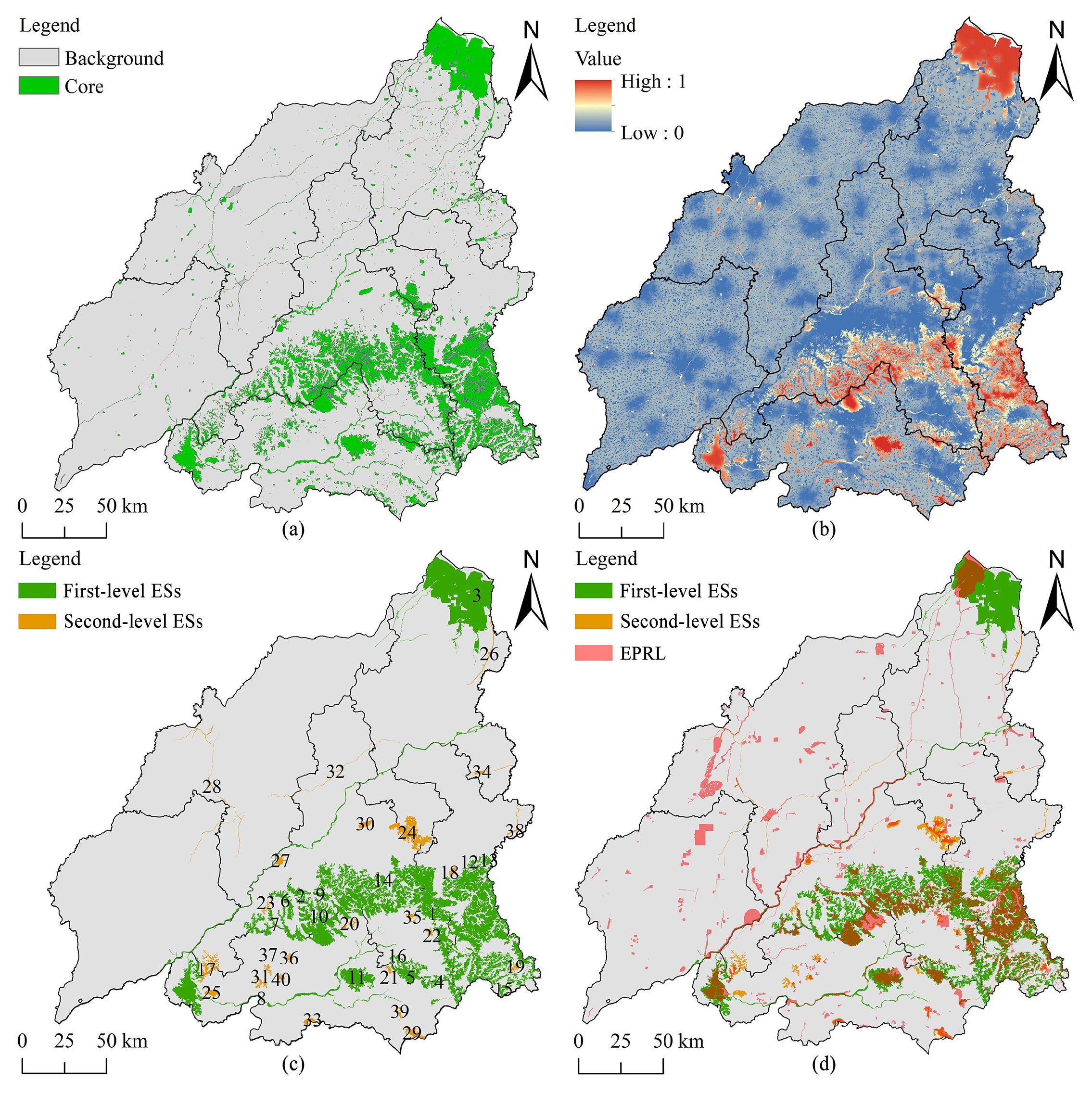
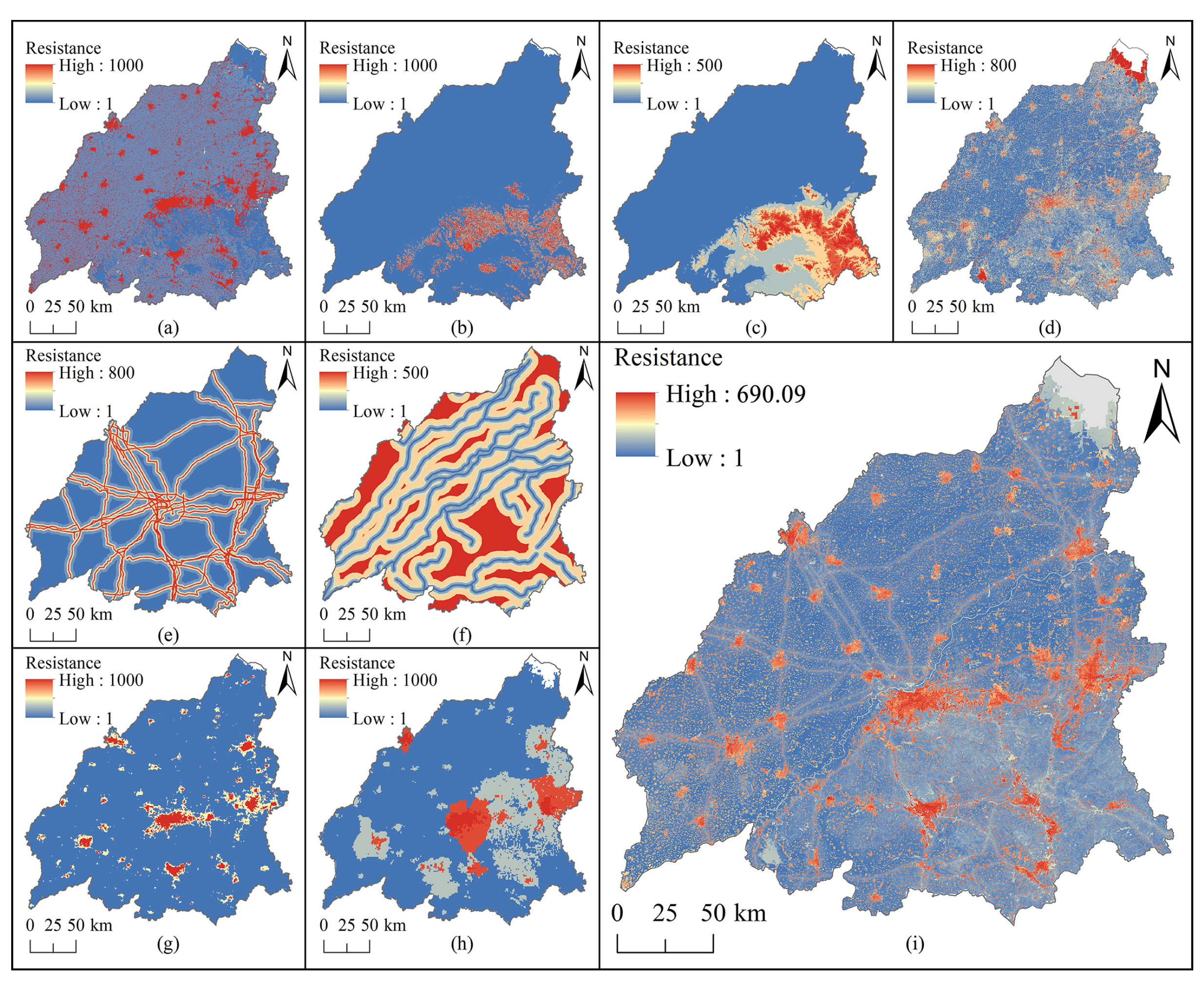
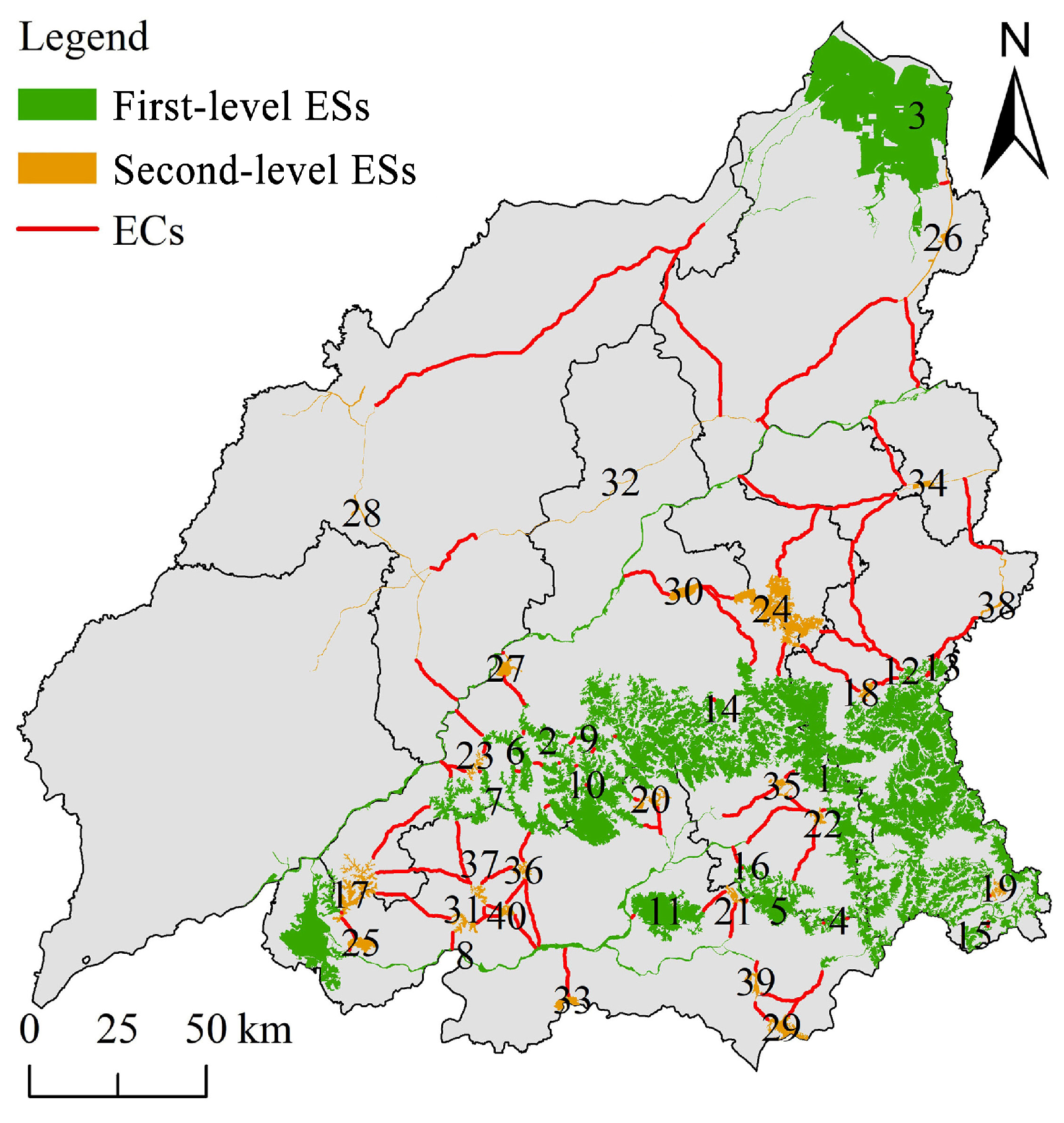
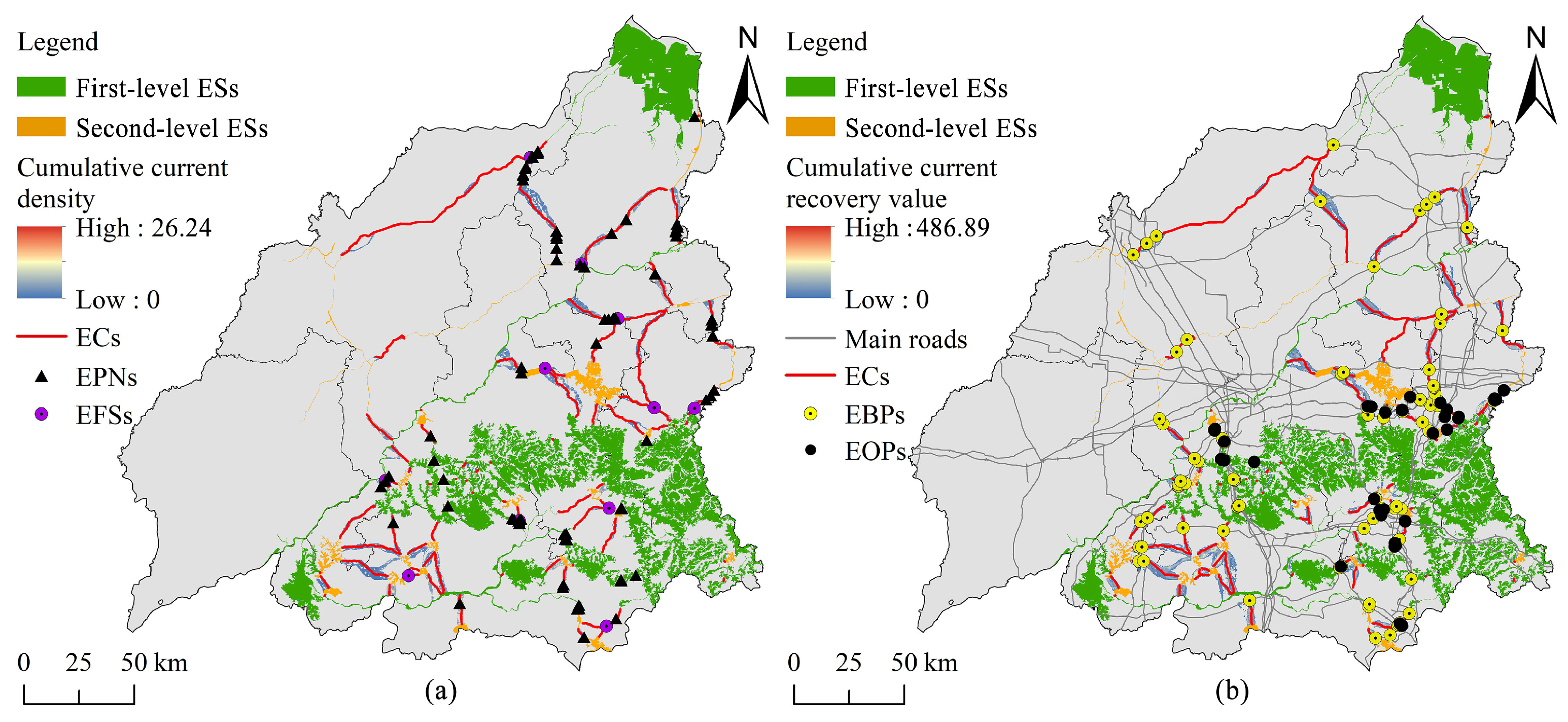

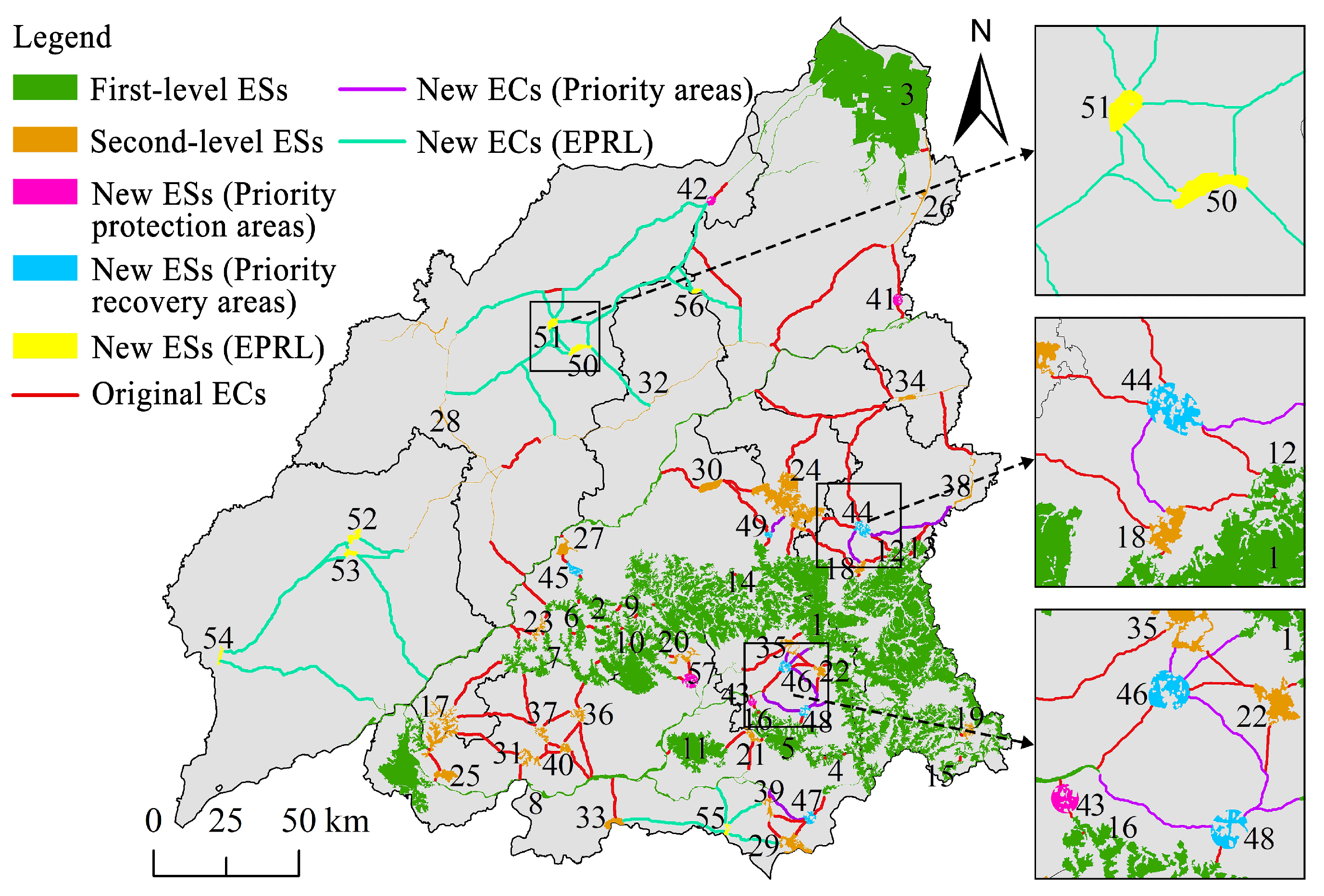
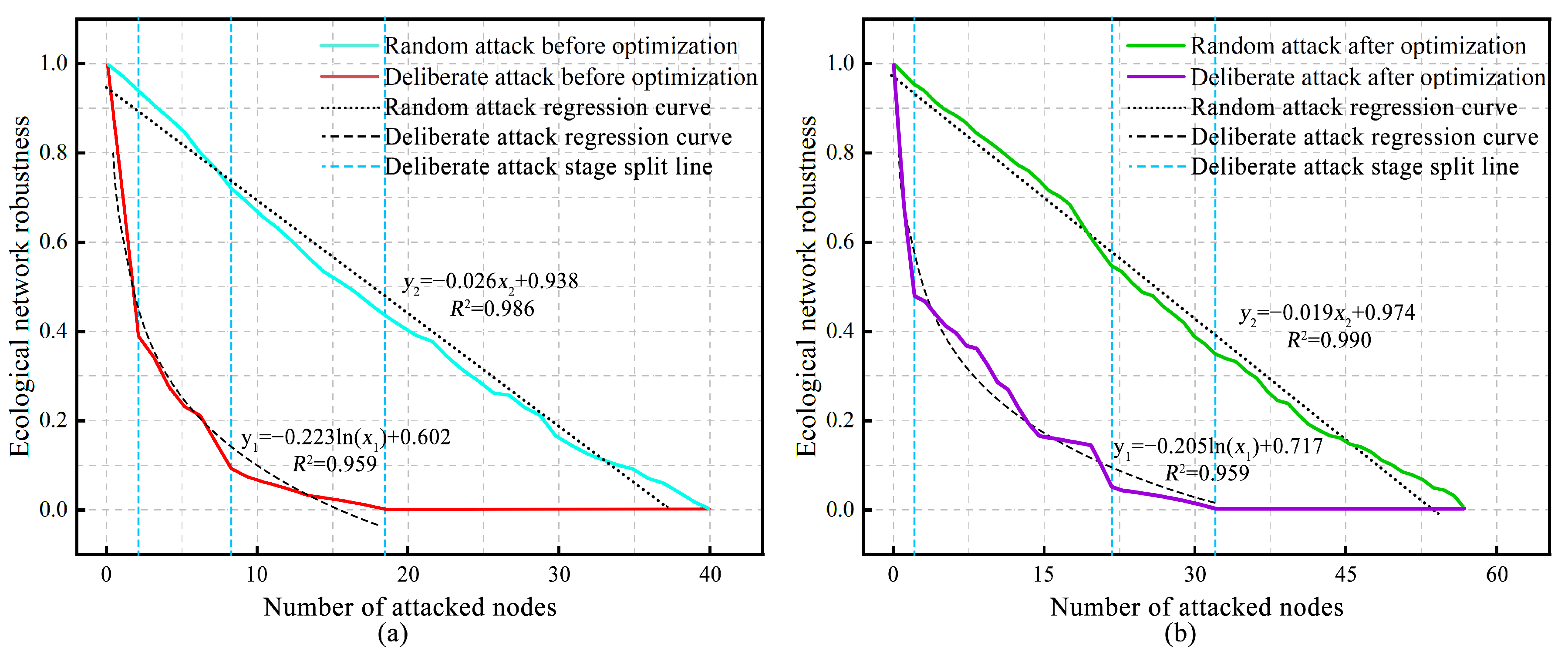

| Data Type | Year | Resolution | Data Sources |
|---|---|---|---|
| LULC | 2020 | 30 m × 30 m | Resource and Environment Science Data Center of Chinese Academy of Sciences (RESDC) (http://www.resdc.cn (accessed on 12 February 2024)) |
| Digital elevation model data (DEM) | 2020 | 30 m × 30 m | RESDC (http://www.resdc.cn (accessed on 12 February 2024)) |
| Slop | 2020 | 30 m × 30 m | Generated by DEM calculation |
| Gross domestic product (GDP) | 2020 | 1 km × 1 km | RESDC (http://www.resdc.cn (accessed on 8 April 2024)) |
| Nighttime lighting | 2020 | 1 km × 1 km | NOAA National Centers for Environmental Information (http://www.ngdc.noaa.gov/ (accessed on 8 April 2024)) |
| Road and River | 2020 | vector data | OpenStreetMap (https://www.openstreetmap.org (accessed on 14 April 2024)) |
| Normalized difference vegetation index (NDVI) | 2020 | 30 m × 30 m | National Ecosystem Science Data Center (https://nesdc.org.cn (accessed on 15 April 2024)) |
| EPRL | 2020 | vector data | Shandong Provincial Department of Ecological Environment (http://gcc.sdein.gov.cn/dtxx/201610/t20161020_711402.html (accessed on 15 June 2024)) |
| Threat | Maximum Threat Distance (km) | Weight | Decay Type |
|---|---|---|---|
| Cultivated land | 3 | 0.5 | Linear |
| Urban land | 10 | 1 | Index |
| Rural residential | 5 | 0.7 | Index |
| Industrial land | 7 | 0.9 | Index |
| Unused land | 1 | 0.3 | Linear |
| LULC | Habitat Suitability | Threat Factor | ||||
|---|---|---|---|---|---|---|
| Cultivated Land | Urban Land | Rural Residential | Industrial Land | Unused Land | ||
| Cultivated land | 0.4 | 0 | 1 | 0.5 | 0.6 | 0.2 |
| Forestland | 1 | 0.8 | 1 | 0.7 | 0.8 | 0.4 |
| Grassland | 0.8 | 0.6 | 0.8 | 0.6 | 0.7 | 0.6 |
| Water | 0.9 | 0.7 | 0.9 | 0.7 | 0.8 | 0.3 |
| Construction land | 0 | 0 | 0 | 0 | 0 | 0 |
| Unused land | 0 | 0.5 | 0.6 | 0.6 | 0.6 | 0 |
| Type | Weight (%) | Classification | Reclassification Weight |
|---|---|---|---|
| MSPA | 40 | Core | 4 |
| Bridge | 3 | ||
| Perforation | 1 | ||
| Edge | 1 | ||
| Islet | 2 | ||
| Loop | 2 | ||
| Branch | 1 | ||
| HQ | 60 | High-HQ area (0.75–1) | 4 |
| Medium-high-HQ area (0.50–0.75) | 3 | ||
| Medium-low-HQ area (0.17–0.50) | 2 | ||
| Low-HQ area (0–0.17) | 1 |
| Connectivity Index | Connection Distance Threshold (m) | |||||||
|---|---|---|---|---|---|---|---|---|
| 100 | 200 | 500 | 1000 | 1500 | 2000 | 2500 | 3000 | |
| PC | 0.559 | 0.564 | 0.579 | 0.597 | 0.603 | 0.603 | 0.605 | 0.606 |
| IIC | 0.562 | 0.571 | 0.600 | 0.633 | 0.643 | 0.648 | 0.651 | 0.655 |
| Factors | Weight | Grade | Resistance Value | Factor | Weight | Grade | Resistance Value |
|---|---|---|---|---|---|---|---|
| LULC | 0.33 | Forestland, Grassland | 1 | Distance from road (m) | 0.07 | >5000 | 1 |
| Water | 10 | 2000–5000 | 100 | ||||
| Cultivated land | 100 | 1000–2000 | 300 | ||||
| Unused land | 500 | 500–1000 | 500 | ||||
| Construction land | 1000 | 0–500 | 800 | ||||
| NDVI | 0.23 | >0.87 | 1 | Distance from river (m) | 0.05 | 0–1000 | 1 |
| 0.79–0.87 | 100 | 1000–3000 | 100 | ||||
| 0.68–0.79 | 300 | 3000–5000 | 200 | ||||
| 0.54–0.68 | 500 | 5000–10,000 | 300 | ||||
| 0–0.54 | 800 | >10,000 | 500 | ||||
| DEM (m) | 0.16 | ≤86 | 1 | GDP (ten thousand yuan/km2) | 0.03 | 341–3577 | 1 |
| 86–212 | 100 | 3577–9353 | 100 | ||||
| 212–354 | 200 | 9353–25,837 | 300 | ||||
| 354–534 | 300 | 25,837–109,221 | 500 | ||||
| >534 | 500 | >109,221 | 1000 | ||||
| Slope (°) | 0.11 | 0–2.45 | 1 | Nighttime lighting (nW/cm2/sr) | 0.02 | 0–3.93 | 1 |
| 2.45–6.98 | 100 | 0.393–13.14 | 100 | ||||
| 6.98–12.83 | 200 | 13.14–29.45 | 300 | ||||
| 12.83–20.14 | 500 | 29.45–101.25 | 500 | ||||
| >20.14 | 1000 | >101.25 | 1000 |
| ES Code | Area (km2) | dPC | ES Code | Area (km2) | dPC |
|---|---|---|---|---|---|
| 1 | 3088.15 | 87.36 | 9 | 26.95 | 1.21 |
| 2 | 77.04 | 9.04 | 10 | 26.08 | 1.17 |
| 3 | 1074.34 | 8.07 | 11 | 163.58 | 0.98 |
| 4 | 21.98 | 7.72 | 12 | 15.53 | 0.96 |
| 5 | 158.66 | 7.06 | 13 | 18.09 | 0.82 |
| 6 | 64.30 | 5.70 | 14 | 16.61 | 0.67 |
| 7 | 166.58 | 3.91 | 15 | 23.09 | 0.57 |
| 8 | 509.84 | 3.20 | 16 | 12.42 | 0.50 |
| Search Radius (m) | 3000 | 4000 | 5000 | 6000 |
|---|---|---|---|---|
| Number of new ESs (Priority protection areas) | 1 | 2 | 4 | 4 |
| Number of new ESs (Priority recovery areas) | 0 | 1 | 6 | 6 |
| Total area (km2) | 8.43 | 25.67 | 104.81 | 144.35 |
| Number | Name | Ecological Function | Area (km2) |
|---|---|---|---|
| 50, 51 | Dezhou Hongtan Temple Forest Park windproof sand fixation, biodiversity maintenance EPRL | Windbreak and sand fixation, biodiversity conservation | 13.83 |
| 52, 53 | Chiping Yellow River heritage soil conservation EPRL | Soil conservation, water conservation, biodiversity conservation | 21.55 |
| 54 | West of Majia River in Shen County soil conservation EPRL | Soil conservation, biodiversity conservation, water conservation, | 6.67 |
| 55 | Xintai southern hilly biodiversity conservation EPRL | Biodiversity conservation, water conservation, soil conservation | 7.10 |
| 56 | North of Shahe River biodiversity conservation EPRL | Biodiversity conservation, water conservation, soil conservation, | 5.23 |
Disclaimer/Publisher’s Note: The statements, opinions and data contained in all publications are solely those of the individual author(s) and contributor(s) and not of MDPI and/or the editor(s). MDPI and/or the editor(s) disclaim responsibility for any injury to people or property resulting from any ideas, methods, instructions or products referred to in the content. |
© 2025 by the authors. Licensee MDPI, Basel, Switzerland. This article is an open access article distributed under the terms and conditions of the Creative Commons Attribution (CC BY) license (https://creativecommons.org/licenses/by/4.0/).
Share and Cite
Liu, X.; Zhang, F.; Gao, Q.; Li, T.; Zhang, R.; Jia, Y. Optimizing the Ecological Network to Construct an Ecological Security Pattern in a Metropolitan Area: A Case Study of the Jinan Metropolitan Area, China. Sustainability 2025, 17, 7342. https://doi.org/10.3390/su17167342
Liu X, Zhang F, Gao Q, Li T, Zhang R, Jia Y. Optimizing the Ecological Network to Construct an Ecological Security Pattern in a Metropolitan Area: A Case Study of the Jinan Metropolitan Area, China. Sustainability. 2025; 17(16):7342. https://doi.org/10.3390/su17167342
Chicago/Turabian StyleLiu, Xinlong, Fangyuan Zhang, Qingrui Gao, Tianlu Li, Renhe Zhang, and Yanyan Jia. 2025. "Optimizing the Ecological Network to Construct an Ecological Security Pattern in a Metropolitan Area: A Case Study of the Jinan Metropolitan Area, China" Sustainability 17, no. 16: 7342. https://doi.org/10.3390/su17167342
APA StyleLiu, X., Zhang, F., Gao, Q., Li, T., Zhang, R., & Jia, Y. (2025). Optimizing the Ecological Network to Construct an Ecological Security Pattern in a Metropolitan Area: A Case Study of the Jinan Metropolitan Area, China. Sustainability, 17(16), 7342. https://doi.org/10.3390/su17167342





